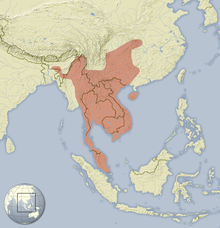Asiatic brush-tailed porcupine
| Asiatic brush-tailed porcupine | |
|---|---|

| |
| Scientific classification | |
| Domain: | Eukaryota |
| Kingdom: | Animalia |
| Phylum: | Chordata |
| Class: | Mammalia |
| Order: | Rodentia |
| Family: | Hystricidae |
| Genus: | Atherurus |
| Species: | A. macrourus
|
| Binomial name | |
| Atherurus macrourus | |

| |
| Synonyms | |
|
Hystrix macroura Linnaeus, 1758 | |
The Asiatic brush-tailed porcupine (Atherurus macrourus) is a species of rodent in the family Hystricidae. It is found in China, Bhutan, India, Laos, Malaysia, Myanmar, Thailand, and Vietnam.
Taxonomy
[edit]The synonyms of this species are Atherurus assamensis (Thomas, 1921), and Atherurus macrourus (Thomas, 1921) subspecies assamensis.[1]
Habitat
[edit]It is a nocturnal and fossorial species, occurring in subtropical and tropical montane forests. It is found on the forest floor, often in areas with profuse undergrowth interspersed with cane and bamboo brakes and palms.[2]
Breeding
[edit]It constructs burrows, which may be occupied by up to three animals. The female produces one or two litters a year, of a single young, after a gestation period of 100 to 110 days.[3]
Conservation
[edit]Known to be one of the rarest porcupines in South Asia,[4] the species is protected under Schedule II of the Indian Wildlife (Protection) Act, though not listed in CITES. It has been recorded from Namdapha National Park in Arunachal Pradesh, India.[5] It is present in a number of protected areas in Southeast Asia.
Behavior
[edit]In one study using camera traps, it was found that the porcupine typically hunts at night, with a single activity peak during the three-hour period before midnight. To avoid predators on nights when the moon is full, foraging activity is limited to dawn and dusk.[6]
References
[edit]- ^ a b Molur, S. (2020). "Atherurus macrourus". IUCN Red List of Threatened Species. 2020: e.T2354A166518819. doi:10.2305/IUCN.UK.2020-1.RLTS.T2354A166518819.en. Retrieved 11 November 2021.
- ^ Molur, S.; Srinivasulu, C.; Srinivasulu, B.; Walker, S.; Nameer, P.O.; Ravikumar, L. (2005). Status of non-volant small mammals: Conservation Assessment and Management Plan (C.A.M.P) workshop report. Coimbatore: Zoo Outreach Organisation / CBSG-South Asia. p. 198. ISBN 81-88722-11-1.
- ^ Andrew T. Smith: Asiatic Brush-Tailed Porcupine. In: Andrew T. Smith, Yan Xie: A Guide to the Mammals of China. Princeton University Press, Princeton NJ 2008, ISBN 978-0-691-09984-2, S. 274.
- ^ Dhendup, Tashi; Dorji, Rinzin (2017). "First record of the Asiatic Brush-tailed Porcupine Atherurus macrourus Linnaeus, 1758 (Mammalia: Rodentia: Hystricidae) from western Bhutan". Journal of Threatened Taxa. 9 (11): 10959. doi:10.11609/jott.3791.9.11.10959-10960. ISSN 0974-7907.
- ^ (Molur et al. 2005)
- ^ Wen, Li-Jia; Guo, Yu-Min; Huang, Jian; Song, Yang. "The activity rhythm of the Asiatic brush-tailed porcupine Atherurus macrourus and its correlation with the phases of the moon". Chinese Journal of Zoology. 51 (3): 347–352. Archived from the original on December 19, 2021. Retrieved May 8, 2020.
- Woods, C.A.; Kilpatrick, C.W. (2005). "Species Atherurus macrourus". In Wilson, D.E.; Reeder, D.M (eds.). Mammal Species of the World: A Taxonomic and Geographic Reference (3rd ed.). Johns Hopkins University Press. pp. 1538–1600. ISBN 978-0-8018-8221-0. OCLC 62265494.

